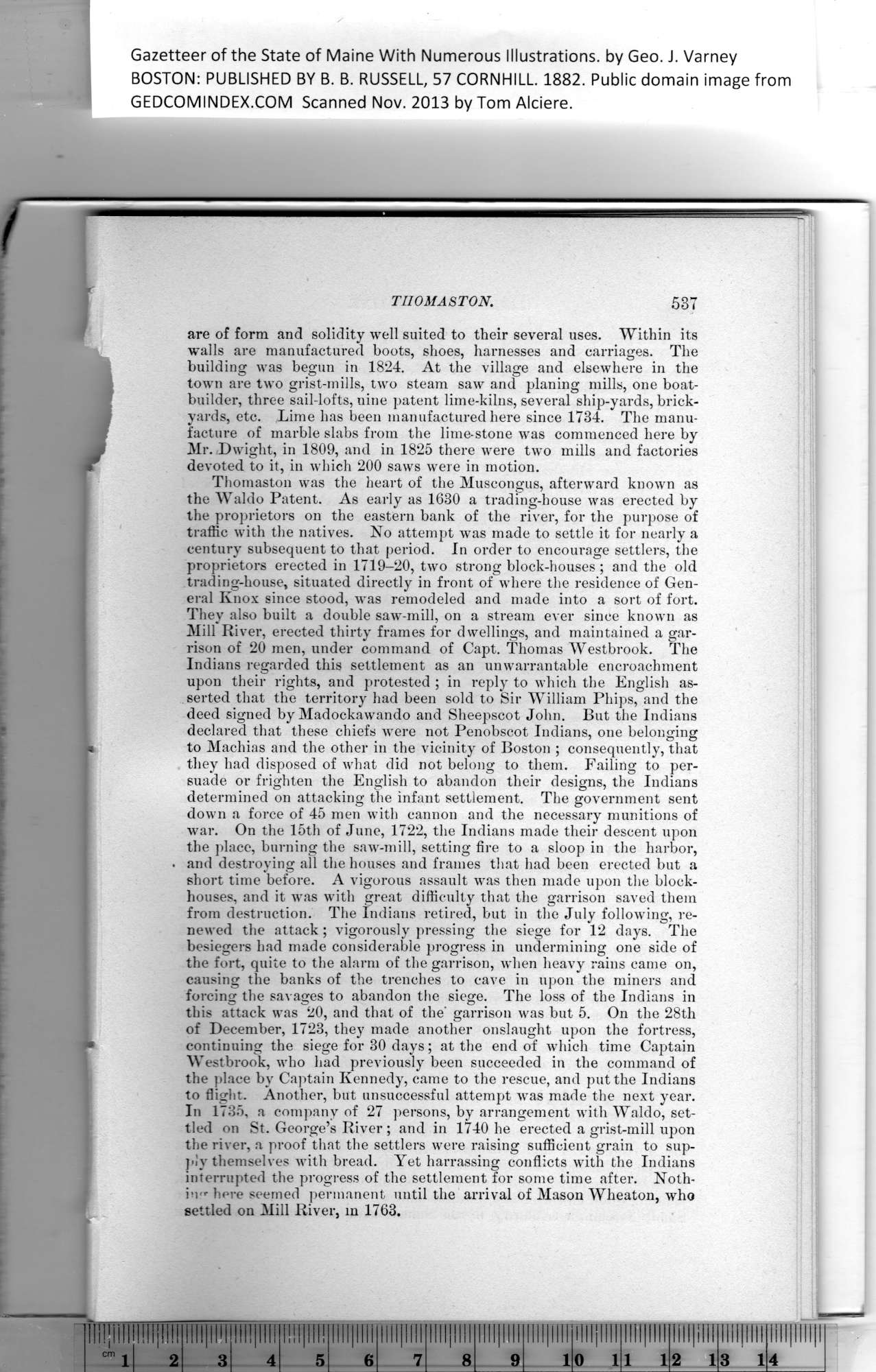|
Gazetteer of the State of Maine With Numerous Illustrations, by Geo. J. Varney
BOSTON: PUBLISHED BY B. B. RUSSELL, 57 CORNHILL. 1882. Public domain image from
THOMASTON. 537
are of form and solidity well suited to their several uses. Within its
walls are manufactured boots, shoes, harnesses and carriages. The
building was begun in 1824. At the village and elsewhere in the
town are two grist-mills, two steam saw and planing mills, one boat-
builder, three sail-lofts, nine patent lime-kilns, several ship-yards, brick-
yards, etc. Lime has been manufactured here since 1734. The manu-
facture of marble slabs from the lime-stone was commenced here by
Mr. Dwight, in 1809, and in 1825 there were two mills and factories
devoted to it, in which 200 saws were in motion.
Thomaston was the heart of the Muscongus, afterward known as
the Waldo Patent. As early as 1680 a trading-house was erected by
the proprietors on the eastern bank of the river, for the purpose of
traffic with the natives. No attempt was made to settle it for nearly a
century subsequent to that period. In order to encourage settlers, the
proprietors erected in 1719-20, two strong block-houses ; and the old
trading-house, situated directly in front of where the residence of Gen-
eral Knox since stood, was remodeled and made into a sort of fort.
They also built a double saw-mill, on a stream ever since known as
Mill River, erected thirty frames for dwellings, and maintained a gar-
rison of 20 men, under command of Capt. Thomas Westbrook. The
Indians regarded this settlement as an unwarrantable encroachment
upon their rights, and protested ; in reply to which the English as-
serted that the territory had been sold to Sir William Phips, and the
deed signed by Madockawando and Sheepscot John. But the Indians
declared that these chiefs were not Penobscot Indians, one belonging
to Machias and the other in the vicinity of Boston ; consequently, that
they had disposed of what did not belong to them. Failing to per-
suade or frighten the English to abandon their designs, the Indians
determined on attacking the infant settlement. The government sent
down a force of 45 men with cannon and the necessary munitions of
war. On the 15th of June, 1722, the Indians made their descent upon
the place, burning the saw-mill, setting fire to a sloop in the harbor,
and destroying all the houses and frames that had been erected but a
short time before. A vigorous assault was then made upon the block-
houses, and it was with great difficulty that the garrison saved them
from destruction. The Indians retired, but in the July following, re-
newed the attack ; vigorously pressing the siege for 12 days. The
besiegers bad made considerable progress in undermining one side of
the fort, quite to the alarm of the garrison, when heavy rains came on,
causing the banks of the trenches to cave in upon the miners and
forcing the savages to abandon the siege. The loss of the Indians in
this attack was 20, and that of the’ garrison was but 5. On the 28th
of December, 1723, they made another onslaught upon the fortress,
continuing the siege for 30 days; at the end of Avliich time Captain
Westbrook, who had previously been succeeded in the command of
the place by Captain Kennedy, came to the rescue, and put the Indians
to flight. Another, but unsuccessful attempt was made the next year.
In 1735. a company of 27 persons, by arrangement with Waldo, set-
tled on St. George’s River; and in 1740 he erected a grist-mill upon
the river, a proof that the settlers were raising sufficient grain to sup-
ply themselves with bread. Yet harrassing conflicts with the Indians
interrupted the progress of the settlement for some time after. Noth-
in''- here seemed permanent until the arrival of Mason Wheaton, who
settled on Mill River, in 1763.
PREVIOUS PAGE ... NEXT PAGE
This page was written in HTML using a program written in Python 3.2
|
